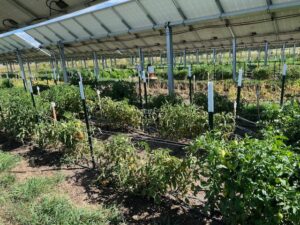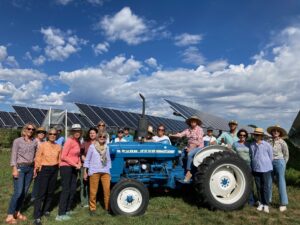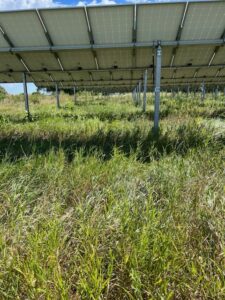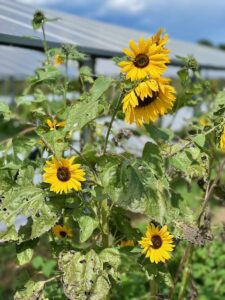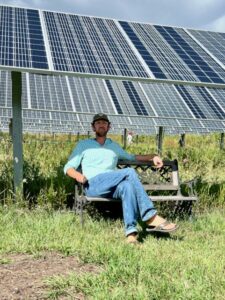When Byron Kominek married his wife, they were excited to inherit a 24 acre farm near Longmont that had been family owned since 1972. The farm produced high quality hay and wheat, but selling these crops wasn’t profitable enough to cover expenses. Throw in a couple years of drought, and the farm was in serious trouble. What could they do to save it? Many family discussions centered around different agriculture and conservation efforts, but their farm was too small to be profitable. Looking out the kitchen window and seeing the large utility poles carrying power lines gave Byron an idea. Could they install solar panels and sell power to the Boulder County power grid? Boulder County embraces renewable energy and encourages all homes and business to use it, so creating renewable energy through solar panels seemed like a perfect fit. But what would happen to the land under the panels? Would the soil be destroyed from the panel installation or could they continue to grow hay or other crops below the panels?
After much research and working with Excel Energy and Boulder County Officials, on November 1, 2020, the solar panels were installed. On four acres of land, 3,200 solar panels provide 1.2 MW electricity – enough to power 300 homes year round. The panels are situated so that they can follow the sun from east to west and are high enough off the ground to allow for crops to grow underneath. There are alternatives to turf or bare ground under solar panels. The co-location of solar and beneficial agriculture is referred to as “agrivoltaics.”
The solar panels provide shade as they rotate through the day – some areas have morning shade, some areas have afternoon shade and a strip on the middle has all day sun. Crops and flowers can be planted to take advantage of this shade. Another benefit of the solar panels is they create their own moisture micro climates. In the summer, rain collects on the panels and drains off them and in the winter, snow collects on them and falls off. This moisture can be preserved through the shade that the panels provide.
“Our research has shown that 95 percent of the soil nutrients can be maintained under solar panels,” said Byron. “And the humidity and moisture from the crops help keep the solar panels cool which helps them produce more electricity. It’s a win-win situation.”
For several years, The University of Arizona has been studying crop growth amid the solar panels. The are measuring crop growth rates and performance based on row location, the rates of photosynthesis (carbon uptake) and transpiration (water loss), and the irrigation savings thanks to the shade provided by the panels overhead. Another study by Colorado State University is measuring soil health below the panels, CO2 sequestration and water retention.
A third organization is involved on the property is the non-profit organization Sprout City Farms. In 2021, Sprout City Farms broke ground on three acres of land under the solar panels to test larger scale crop rotation. In addition to research, Sprout City Farms provides education and the produce is sold through a CSA (Community Supported Agriculture) where local community members can buy shares and receive weekly XXX produce grown under the solar panels. Sprout City Farms co-founder and executive director Meg Caley is a GCA award winner for her passionate and innovative work having received the Elizabeth Abernathy Hull Award in 2016.
Animals can be incorporated into the solar panel installations. Cattle and sheep can graze under the panels, which provide valuable shade during the hot afternoons for the animals. Native birds and insects are attracted to the crops and flowers growing under the panels and appreciate the moisture and shade. Large birds, such as hawks and eagles, generally stay away from the panels preferring to hunt elsewhere, which not a bad thing since this helps the small and medium birds feel more comfortable around the panels. Audubon Rockies, the regional office of the National Audubon Society for Colorado, Wyoming and Utah, created a bird-friendly garden near the solar panels that contains nearly 3,000 perennials. They are studying the relationship between the solar panels and birds and other wildlife.
“In just a few short years our facility has become the largest site in the U.S. for growing diverse crops under solar panels,” said Byron. “Our goal is to increase awareness and to educate the public about this exciting opportunity. Through the Colorado Agrivoltaic Learning Center, we have had more than 4,000 people tour our facility, including many school groups.” Byron happens to be the director of the Colorado Agrivoltaic Learning Center, which encourages sustainability leadership by connecting students, community members, and policy makers to clean energy, local food and responsible land use management through agrivoltaic tours and events.
“With the ever increasing threat of climate change, it’s imperative that we invest more in renewable energy, including solar energy,” said Byron. “Developing innovative projects that boost renewable energy while preserving the health of our land is crucial.”
